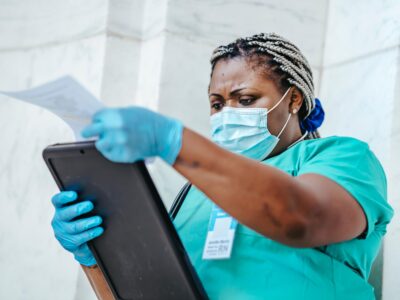The COVID-19 pandemic has ushered in a new era for healthcare workers. Nations all over the globe are realizing how vital these individuals can be. However, the world is also facing a massive shortage of these essential workers.
Last April, the World Health Organization released its State of the World’s Nursing 2020 report, which predicts that the global nursing workforce will face a shortage of 5.7 million workers over the next decade unless nations increase funding to educate and employ more nurses.
That’s why the WHO has designated 2021 as the International Year of Health and Care Workers. Member states are talking openly about the need to recruit, train, and hire more workers over the next few years as demand for healthcare services continues to skyrocket across the globe.
Updating the “Code”
Member states of the WHO met virtually in November during the 73rd World Health Assembly. Many voiced their concerns over the lack of available nursing talent in their home countries. Since the pandemic, international leaders have been acutely focused on the global nursing shortage. They were quick to recognize that these workers are crucial when it comes to ensuring prosperity.
During the meeting, member states discussed the growing scale of healthcare worker migration as providers move in search of better-paying jobs. This puts less affluent countries at a disadvantage, especially as the population continues to age.
The WHO reports that more than 4 million nurses have been added to the global nursing workforce since 2013, however, the vast majority are working in countries that account for only half of the world’s population.
In the African region, for example, there are fewer than 10 nurses per 10,000 people, while parts of Europe, the U.S. and Australia have 10 times as many nurses per 10,000 people.
The meeting focused on what’s known as the WHO Global Code of Practice on the International Recruitment of Health Personnel (Code), which many developing countries use to recruit and retain healthcare providers. Member states called on the WHO to update the “code” while strengthening its financing, implementation, and monitoring.
The assembly eventually voted to strengthen the code in the wake of the deadly COVID-19 pandemic.
After the decision was made, Jim Campbell, Director of the Health Workforce Department in WHO headquarters, released a statement:
“Today’s decision gives clear direction on consensus and the necessary actions on the health and care workforce. WHO urges all member states, international financing institutions, global health initiatives and partners to invest in health workforce readiness, education, and learning to manage the pandemic, maintain health services, and prepare for a COVID-19 vaccine.”
As healthcare workers continue to migrate to new countries, it seems western nations like the U.S. are pulling talent away from countries in need.
“We need to ask questions about whether we have it right here in the United States. In many countries, prescribing is for registered nurses, not just advanced practice nurses, and it has been proven again and again to be safe, improve access, and benefit patients.” said David Benton, PhD, RN, a member of the steering committee for the report and CEO for the National Council of State Boards of Nursing.
The WHO reports that in high-income countries, 15.2% of the nursing workforce reported being foreign-born or foreign-trained, which suggests these nations need to “look at producing enough nurses of their own so they are not drawing from countries that cannot afford to lose them,” said Carey McCarthy, PhD, MPH, RN, technical officer for WHO’s health workforce department.
The organization estimates that scaling up the education and recruitment of nurses would cost about $10 per capita per year in the affected low- and middle-income countries.
McCarthy added, “Most countries can do this with domestic funds, even low- and middle-income countries. International financing organizations like the World Bank can target development assistance to help achieve this goal.”
Using Data to Influence Policy
The WHO is collecting and sharing data on the global nursing shortage to motivate international leaders to invest in the nursing workforce. Making matters worse, the WHO estimates that 1 in 6 of the world’s nurses are expected to retire in the next 10 years.
“We are asking countries to look at their national data and use that to dive into policy dialogues to decide where and how to invest,” McCarthy added.
“We have a near complete picture of the global nursing workforce for the first time, which is important for planning,” Benton said. “We have a fundamental starting point, which will allow us to track the progress we make.”
The State of the World’s Nursing report includes 10 steps that must be taken to advance the global nursing workforce:
- Countries affected by shortages will need to increase funding to educate and employ at least 5.9 million additional nurses.
- Countries should strengthen capacity for health workforce data collection, analysis, and use.
- Nurse mobility and migration must be effectively monitored and responsibly and ethically managed.
- Nurse education and training programs must graduate nurses who drive progress in primary healthcare and universal health coverage.
- Nursing leadership and governance is critical to nursing workforce strengthening.
- Planners and regulators should optimize the contributions of nursing practice.
- Policy makers, employers and regulators should coordinate actions in support of decent work.
- Countries should deliberately plan for gender-sensitive nursing workforce policies.
- Professional nursing regulation must be modernized.
- Collaboration is key.
View the full report to learn more about this new campaign and how it could change the future of nursing.

















